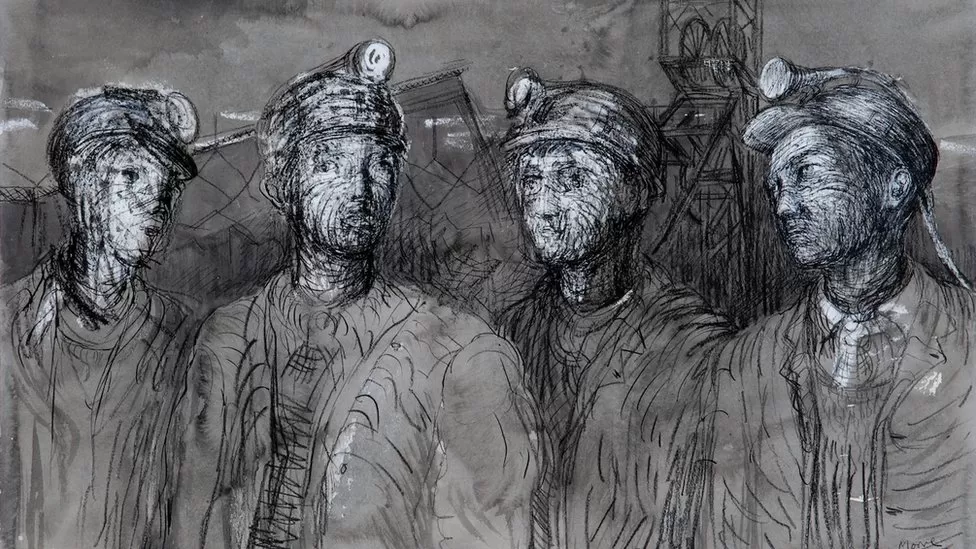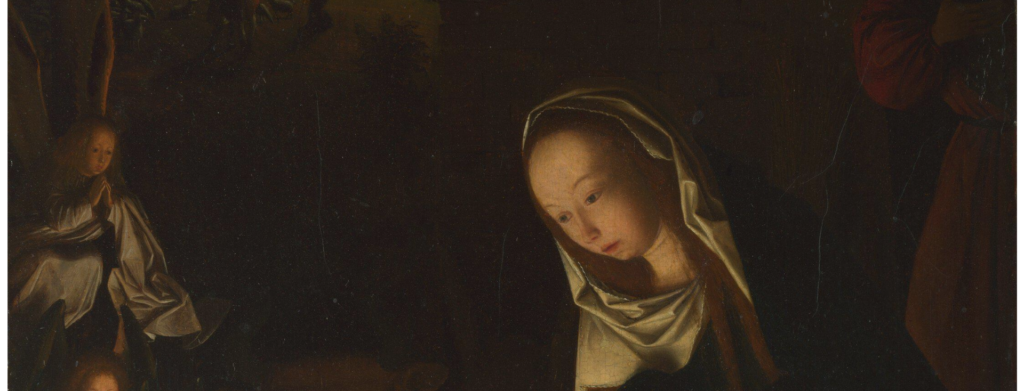In Henry Moore’s wartime dark grey pencil sketches, drawn from huddled life as seen in London’s air raid shelters and hard labour as conscripted into Castleford’s coal pits, everyone and everything was trapped deep in cramped, dominating darkness.
Even in Pit Boys at Pit Head, which was a sketch of four miners drawn in the daytime and above ground, the darkness of coal dust and dirt still covered the scene – the miners, the spoil heaps in the background, the ashen sky, were all overcast by it.

And yet, in this sketch the artist managed to discern and to gently trace out the contours and contrasts of the faces to show a stark and simple dignity in the appearances of the four men – an artistic eloquence perhaps made possible by a connection and mutual understanding between the artist and his subjects, for Moore was a coal miner’s son: he had shared their experience of life in the dark.
His use of dark grey pencil against tiny glimpses of white paper showed such lightness of human character to still be alive in and underneath the dark of the coal dust and dirt.
Thanks to the light of Moore’s insight, he made visible to those who viewed these drawings all the details of survival, labour, strain and fear: such was the harsh reality of a life experienced down in the dark. Such was the reality that marked but did not eclipse the humanity of those who endured it.
In renaissance portraits showing the Christ child, the contrast between darkness and light was often heightened to an extreme, by a golden glow of glory surrounding the child’s crib. Sometimes this was burnished in real gold leaf. It threw the rest of the scene into shadow, and what else is there could hardly be discerned by the viewer behind layers of dusky oil paint and heavy varnish.
One renaissance image of the Christ child, by Geertgen tot Sint Jans, is set at night. Yet the child themself shone so brightly – almost like a plug-in night light – that he allowed the artist to clearly show the loving and adoring faces that surrounded him: the face of his mother and the faces and wings of a gathering of angels, which were flooded with his reflected glory so that they too stood luminous against the backdrop of a gloomy stable scene.

All the delicacy of respect for new life, and hope for flourishing, fulfilment and peace were visible in their brightened faces, and would have been clearly seen by the owners of this devotional image.
For by the Christ-child’s light those who gazed upon it could see the scene of his birth; and by implication view the world beyond the stable and the frame also: view their own faces as if they were illuminated by his glory, even against a backdrop of darkness.
The first, poetic chapter of the Gospel of John depicts light shining in and into darkness: a light that came into the world when the Word of God, who created all worlds, became human flesh in the person of Jesus.
The light of which John writes illuminates and enlightens, all those who receive God’s Word in his – in our shared – human flesh. In such light, true humanity can be seen: for Jesus shone with it, to share with us in it.
In such light, we can learn how to see ourselves and others as dignified and humane, bathed and cleansed in the presence of the lightening humanity of Jesus: being drawn up out of the darkness to be sustained and held in the light by him.
In such light, we are also able to shine within the reflected glory of the Word’s divinity.
There is great power in John’s image of a light that shines in darkness, by which we see what we ought to be; see how we might become; and see from where all our hope and salvation comes.
On this dark night, and in many other times and places of darkness, let us continue to learn how we may see all things by the light of Christ’s glory: the glory as of a father’s only Son, full of grace and truth.
The light of Christ inspires us so that we may see the true humanity of all people and fight for its recognition; so that we may awake to the pursuit of justice and peace; so that we may understand the world’s nature and beauty more truly, and safeguard them.
The light of Christ inspires us to find and kindle other lights in the world around us, and by their brightening also, resist the powers of darkness in this world.
On this dark night, and in many other times and places of darkness, let us continue to learn how we may see all things by the light of Christ’s glory: the glory as of a father’s only Son, full of grace and truth.